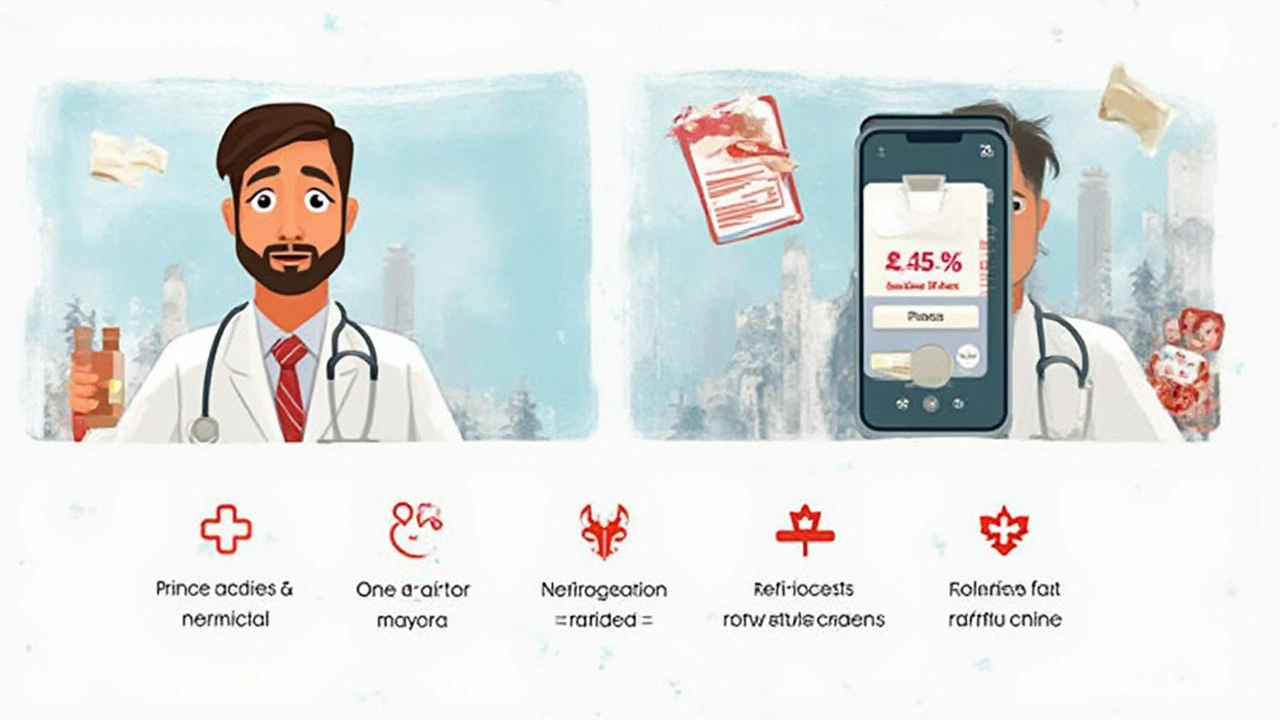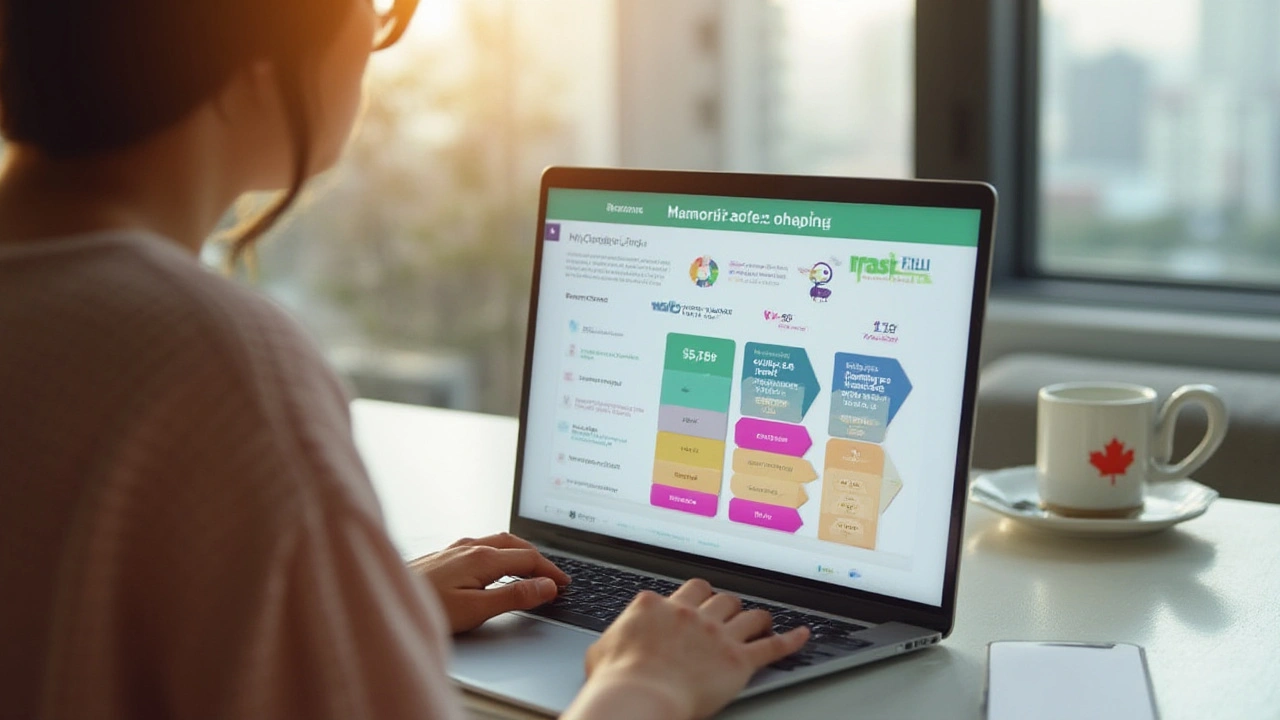Finding the right online clinic in Canada these days is almost as tricky as finding a good parking spot downtown on a Saturday—just way less likely to leave your bumper scratched. Since 2020, telemedicine hasn’t just taken off, it’s become the main way a lot of folks get prescriptions, talk to doctors, and handle everything from allergies to mental health meds without leaving home. If you’ve scrolled through Google for just ten minutes, you know the options feel endless, but how do you actually pick one that won’t waste your time or drain your wallet?
The Real Cost: Pricing and Hidden Fees
First off, let’s talk dollars. The advertised price and the real price you pay can be pretty different. Felix likes to show off its fixed monthly subscription model, which sits around $40 for assessments. You only pay for what you need—straightforward, but make sure to check if medication costs are included because most of the time, they’re not. Maple plays it differently, with a pay-per-visit setup. A visit runs anywhere from $49 to $99 depending on the urgency and time of day. Some people find this model cheaper if they’re not using the service every month.
Then there’s insurance. Not all clinics are created equal when it comes to direct billing or providing receipts that insurance likes. Felix emails out receipts and makes insurance claims pretty simple. Maple, on the other hand, is often covered by employer health plans—if your company offers Maple, you can get visits totally free or heavily discounted. That feels almost too good to be true, but it actually works. Watch for medication delivery charges too, especially if you’re living somewhere out of the big cities—a lot of smaller towns get dinged with extra shipping costs or longer delivery windows.
Hidden fees are the most annoying part. Refill requests, urgent consults, or even chatting back and forth with your assigned doctor can add extra charges on some platforms. Read the terms. These extra costs add up. I’ve seen users share that their $40 visit suddenly ballooned to $80 after tacking on fees for a phone chat and an urgent refill.
Doctor Access: How Fast Can You Get Care and with Whom?
This one’s straight to the point—how fast can you actually talk to a licensed human who knows their stuff? Maple has made a name for itself on speed. If you wake up with a sinus infection on a Sunday, you can usually see a physician within minutes. Their network is huge, so they cover every province, even if you’re hanging out with your cat Ludo up north somewhere. Felix is a bit different; it’s all asynchronous. You fill out an in-depth questionnaire, send it in, and then wait for a doctor to review and respond, usually within 24 hours. That works great for refills or routine prescriptions, but not so much if you have a new urgent issue that needs a human touch.
Now, let’s be real about who you’re talking to. Most telehealth clinics, by law, require physicians to be licensed in your province. That’s good news for your insurance and for peace of mind. But check if you’re actually seeing a doctor or a nurse practitioner. For certain meds—especially mental health or controlled substances—you’ll need a doctor, not a nurse practitioner, and not every clinic has them on staff at all hours. Maple offers both, which gives them an edge if your needs might change quickly. Felix is more focused on ongoing, stable care, and they’re up-front about when and what they can prescribe.
Connection methods matter more than most people think. Maple lets you pick video, chat, or audio calls. Felix sticks to asynchronous messaging for the whole process, which some folks love because there are no awkward live chats—just answer at your own pace. But if you need to clarify your symptoms with questions or want to see how your doctor reacts, live options from Maple or others like Tia Health give you that old-school doctor visit feeling, just minus the cold waiting room.

Prescription Refills and Delivery Times: How Quickly Can You Get Meds?
No one wants to play chicken with their last pill, hoping delivery comes before the next dose is due. Most folks I know have run into this at least once—and it’s stressful. Felix is known for fast turnaround. If you’re on one of their supported medications, orders placed before noon can sometimes arrive at your door the very next day in bigger cities like Toronto and Vancouver. Smaller towns might wait up to three days, depending on shipping and weather (don’t even get me started about Canadian springs).
Maple is a little less consistent. If your provider sends the prescription to a pharmacy near you, it’s up to the pharmacy to fill and deliver—or have you pick up. For some, this works better, especially if you have a favorite local pharmacy that already knows you by name. The catch? Not all medications can be delivered by every pharmacy. If you want direct-to-door shipping, Maple can coordinate, but it varies between provinces.
Looking at speed, let’s break down some averages in a table for Felix and Maple, drawn from their public FAQs and recent customer stories posted on Reddit in 2025:
| Provider | Same-day Approval | 1-2 Day Delivery (urban) | 3+ Day Delivery (rural) | Pharmacy Pickup Available |
|---|---|---|---|---|
| Felix | Yes | 80% | 20% | No |
| Maple | Sometimes | 50% | 50% | Yes |
One interesting tidbit—Felix can actually remind you before you run out, which is a lifesaver (I wish my vet did that for Ludo’s flea meds). But this only works if you stick with their mail-order pharmacy, so consider whether you want that flexibility or not. If you travel often or spend half the year in another province, some clinics aren’t able to serve you outside your home province, even virtually.
Comparing the Most Popular Platforms: Felix, Maple, and the Rest
Let’s get into the meat of it: How do the big names really stack up? Beyond Felix and Maple, Canadians also turn to Tia Health, Cover Health, and Mednow—each with their unique quirks.
Felix is easy on the user experience. They focus on repeat medications: birth control, ED, hair loss, mental health meds. You won’t get a live appointment, and they don’t handle urgent care. But for the stuff you need regularly, it’s simple, private, and doesn’t waste your time. Maple covers way more territory: general consults, mental health, dermatology, and more complex cases. That comes with the price of a less streamlined refill workflow but opens up a world of options if you don’t know exactly what’s wrong.
Tia Health has a growing base for integrating with provincial health cards to cover consults. For example, in Ontario, you can access many services with your OHIP card. Mednow leans into pharmacy-first solutions—think virtual pharmacy, then healthcare.
Folks trying to decide between Felix and Maple should check out the direct comparison at Felix vs Maple telemedicine, which breaks down practical differences and digs into user experiences.
Let’s clear up a myth: Telehealth quality isn’t just about the flashiest app. The reliability of the clinic’s medical team, how quick their support gets back to you, and whether they actually follow up on renewals matter just as much. As a
spokesperson from the Canadian Medical Association noted, "Convenience should never come at the cost of quality or transparency in virtual care."That quote really sticks. Anyone can put up a slick website—but can you actually get safe, legal, timely help?
One underrated aspect is transparency. Both Felix and Maple have clear privacy policies and data handling procedures. Make sure any service you use keeps your data in Canada (where privacy laws protect you), not just on a random server overseas.

Actionable Tips: Making Your Final Choice
If you’re still on the fence, here’s how to break the tie based on your actual needs instead of the shiniest marketing:
- Check the clinic’s list of supported conditions. Not every platform does everything. If you’re looking for specialized treatments outside the basics, go for Maple or Tia Health.
- Compare pricing beyond the initial visit—include subscription, medication, shipping, and hidden fees. Ask for a full estimate up front.
- If speed matters, go with the provider known for turnaround in your area. Felix is faster for basic prescriptions, Maple wins for fast general medical care.
- Want to use your insurance or employee benefits? See if your plan covers the service. If not, ask about making insurance claims easy.
- Read user reviews from platforms like Reddit or Product Hunt. Look for stories about real wait times and service hiccups—don’t just trust testimonials on company websites.
- Check for regulated doctors or nurse practitioners licensed in your province. Never use an unregulated or overseas clinic; those are often sketchy.
- Look for automatic refill reminders and flexible delivery or pickup options. If your schedule is hectic, this can be a game-changer.
- If privacy is a dealbreaker, verify where your medical data is stored.
- Always test out support with a quick question before getting started—how they answer speaks volumes about what happens if something goes wrong later.
The e-health scene isn’t just tech hype. For Canadians in remote spots or those sick of sitting in crowded waiting rooms, it’s real and practical. I’ve set up my own refills online so I can spend more time arguing with Ludo over who gets the bed at night instead of stressing over missed meds. Do your research, ask about what matters most for you—whether that’s instant appointments or saving a few bucks—and keep these real-world tips handy.

John Power
July 17, 2025 AT 02:08Honestly, I switched from Maple to Felix last year and haven’t looked back. The async model works for me-I’m not always available to hop on a call, and getting a reply by the next morning is fine for my anxiety med refills. Plus, the auto-reminders saved me from running out during a road trip. No more panic-buying pills at 2 a.m. 🙌
Emily Nesbit
July 18, 2025 AT 11:29While Felix offers convenience, its lack of pharmacy pickup options is a glaring oversight for rural users. Maple’s integration with local pharmacies provides critical accessibility, especially in provinces with sparse delivery infrastructure. The assumption that ‘same-day approval’ equals ‘better service’ ignores structural inequities in rural healthcare logistics.
Richard Elias
July 19, 2025 AT 03:34maple is overrated and way too expensive for what you get. flix is way better and you dont need to talk to some stranger on video just to get adderall. also why are people still using pharmacy pickup in 2025? its 2025. mail order is the future. also the table is wrong btw. i checked their site and its not 50% for maple delivery its more like 30%
Scott McKenzie
July 20, 2025 AT 12:03Just wanted to add that if you’re on a tight budget, check if your employer offers Maple-it’s literally free for me and my whole family. Also, don’t sleep on Mednow if you’re in Ontario or BC. They’ve got same-day pickup at like 200+ pharmacies. I got my blood pressure meds before lunch last Tuesday. 🏥💨
Jeremy Mattocks
July 21, 2025 AT 21:29Guys, I’ve used all five of these services over the past three years-Maple, Felix, Tia, Mednow, and even that sketchy one that looks like a crypto site-and let me tell you, the real differentiator isn’t speed or price, it’s follow-up. Felix sends you a summary email with next steps, Maple sometimes forgets to update your file, and Tia actually calls you if your refill request is flagged. I had a panic attack last winter because my antidepressant was delayed and no one responded for 72 hours. Don’t just pick the cheapest or fastest-pick the one that treats you like a person, not a ticket number. Also, if you’re on controlled substances, make sure they have a psychiatrist on staff, not just a nurse practitioner. I learned that the hard way.
Paul Baker
July 21, 2025 AT 23:00maple is good but their app crashes every time i try to book a mental health appt 😭 also why is everyone ignoring cover health? theyre cheaper than both and they deliver to yukon. i got my birth control in 2 days up here and no extra fees. also dont trust those tables theyre from 2023
Zack Harmon
July 23, 2025 AT 02:45THIS IS A SCAM. I got a prescription from Felix for Zoloft and they sent me a bottle of sugar pills. I called customer service and they said ‘oh we’ll send you a new one’ and then ghosted me for 11 days. I had to go to the ER because my anxiety went nuclear. This isn’t healthcare. This is a corporate shell game. DO NOT TRUST THESE COMPANIES. THEY DON’T CARE IF YOU DIE.
Jeremy S.
July 24, 2025 AT 07:17Just use Tia if you’re in Ontario. OHIP covers it. No fees. No drama. Done.
Jill Ann Hays
July 25, 2025 AT 03:21It is imperative to recognize that the commodification of telemedicine services represents a systemic erosion of the physician-patient relationship. The prioritization of efficiency over clinical nuance, the algorithmic delegation of care, and the normalization of asynchronous interaction fundamentally undermine the epistemological foundations of medical practice. One must ask: in the pursuit of convenience, have we sacrificed the very essence of therapeutic presence? The answer, I submit, is unequivocally affirmative.